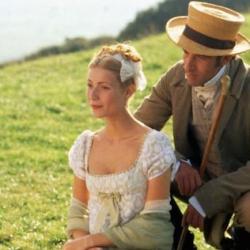We may think that Jane Austen has only recently entered pop culture consciousness. We’d be wrong. Devoney Looser’s The Making of Jane Austen traces Austen’s fortunes between 1833, when her novels were republished, and 1975, the bicentenary of her birth. Looser examines book illustrations, dramatizations of the plays, political deployments of Austen, and Austen in the academy.
Together, “Highbrow, middlebrow, and lowbrow culture makers, whether working together or at cross purposes, collectively changed Austen’s persona from that of a marketable author of sensational domesticity to an apolitical Christian-spinster moralist to an inspirer of women’s suffrage protesters to a flirtatious gender-role-bending demure rebel to the hyper-heterosexual creator of the sexiest fictional man alive” (11-12).
Take, for instance, Eleanor Holmes Hinkley’s play Dear Jane, produced in the 1930s. The play opens in a pub in 1775, where Johnson, Boswell, Joshua Reynolds, and David Garrick are talking about the artistic potential of women. They agree there isn’t much: “there breathes no female alive who is, or ever shall be, capable of true creation” (quoted, 118).
Disproof of their theory is happening in another part of England: Jane Austen is being born and coming to age. The play shows her rejecting “three eligible men—one like Wickham, one like Collins, and one a defective Darcy” so that she can devote herself to her genius (119). Instead of accepting proposals of marriage, she sticks close to her sister Cassandra.
In the end, the sisters Austen escape from the home of the last of the suitors, Sir John Evelyn: “They head off, as anyone who knew Austen’s life story would have known, to an unmarried future together. The play’s final scene, as it’s described, also mirrors a marriage proposal. It produces a no rather than a yes, yet it’s also a love scene. It involves a declaration to a loved one (about not being in love elsewhere) and a dropping down on one’s knees. It provides a twist on the couple riding off into the sunset happily ever after, substituting a running off into the darkness” (121). The actresses who played Jane and Cassandra, Eva Le Gallienne and Josephine Hutchinson, were lovers, which added scandal to the slightly scandalous depiction. Already in 1932, audiences were treated to a “queer Austen.”
Looser’s book is full of forgotten performances, artists, and remakes, showing that Austen has long been enlisted to play a variety of roles and to support causes that would have provoked bemusement, and sometimes embarrassment, in the parson’s daughter.













